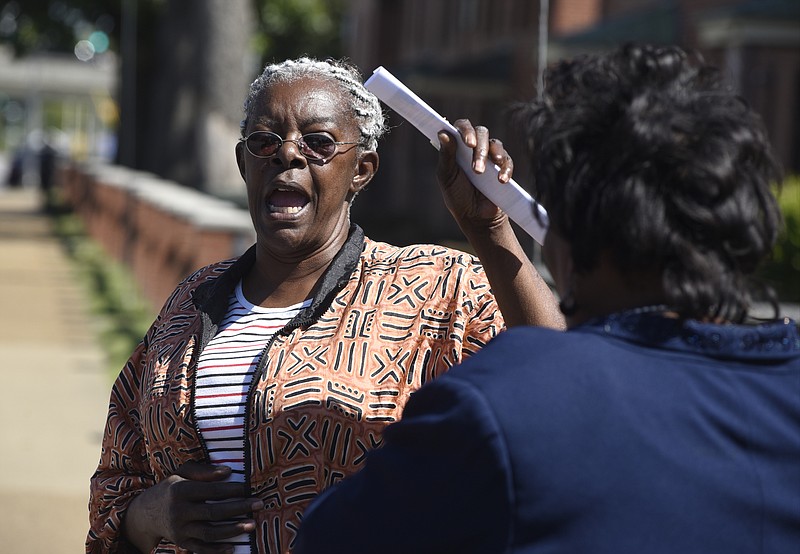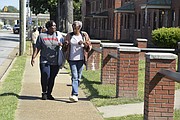Leaders with the NAACP, some clergy and a handful of politicians gathered in East Lake Tuesday to rally support for a comprehensive plan to improve the lives of black Chattanoogans.
Elenora Woods, president of the local NAACP chapter, called for foundations, nonprofits, political leaders, pastors and middle and upper class residents of the city to rally behind the NAACP's effort to collect feedback from residents of the mostly black neighborhoods mired in poverty, crime and limited educational attainment.
The goal, Woods said, is to use the information to develop a comprehensive plan for action.
Read more
* Report about black Chattanoogans offers bleak picture, calls for unified action* Cooper: 'Unfinished agenda' starts at home* Sohn: City's legacy is not renaissance -- yet* Cook: The dream deferred in Chattanooga
The call for partners comes on the heels of a report written by Tennessee State University professor Ken Chilton for the NAACP. It detailed the extent of the inequity between white and black Chattanooga residents.
In the 23-page report, a bleak portrait of a city with two sides was painted with sobering facts about Chattanooga's growing poverty and limited economic mobility.
"The (Chattanooga) renaissance has failed to resonate in the inner city," said Chattanooga City Councilman Larry Grohn. "We have a beautiful city on a hill and the base is all rotten."
For example, in the city's 11 low-income neighborhoods, which are 73 percent black, the average poverty rate is 63.5 percent. Unemployment rates are staggering. In the Westside, where the College Hill Courts housing projects are located, 40 percent of blacks are unemployed. In Alton Park, three quarters of black residents earn less than $25,000 a year. In the Southside, blacks earn, on average, $50,000 less than their white neighbors, according to the report.
With less education and lower wage jobs, many black Chattanoogans find themselves barely able to afford housing. In the most economically devastated neighborhoods, renters devote more than 50 percent of their income to rent, the report says.
"Poverty is the core of our problems," said Woods, who was flanked by black City Councilman Yusuf Hakeem and white City Councilman Grohn, when she spoke to the press. "We need to unite around this problem just like we did with downtown. Everyone should have an American dream."
"It's time we all come together to make the change," said Hakeem.
Improving housing, improving police relationships with residents, improving schools' ability to educate children from struggling neighborhoods and strained families, improving resources and training for new parents, improving early childhood development opportunities for poor families should all be priorities, leaders with the NAACP said. But the ideas for how to make change happen should come from the inner city, not just from elected leaders and foundation boards, said Woods.
"These people live this data everyday," said Chilton, who drove to Chattanooga for the press conference. "We need to give people access to levers of power. If you want to know how to help people, ask those people."
In the coming weeks, Woods said NAACP members plan to return to East Lake and communities like it to talk more with residents and build momentum. They want to register residents to vote and convey the importance of voting, but they also want to explain the findings of the NAACP report and the need to drive a grassroots movement.
To date, no funding has been secured to help hold forums, workshops, conduct surveys and pay consultants and experts, but Woods said she is hopeful financial backers will emerge. After the publication of the report this weekend, she said she was inundated with calls and has meetings lined up that could cement future support.
Some of those meetings will be with foundation heads and political leaders.
"Dr. Woods called our office yesterday to set up a meeting with Mayor [Andy] Berke," said Lacie Stone, a spokesperson for the city. "The mayor looks forward to meeting with leadership of the NAACP to discuss these important issues and to learn more about any of their upcoming initiatives."
Still, some blacks who live isolated in embattled neighborhoods say they are skeptical.
East Lake residents, a few of whom watched the press conference in front of East Lake courts from a distance, worried that the momentary excitement would be little more than grandstanding and inaction.
"They come in, ask for our votes and leave," said one woman who didn't want to give her name.
Many outsiders have known about the problems here, she said. Many have wanted to help.
Still, little seems to change in East Lake, she said, and it's getting harder to believe it ever could.

